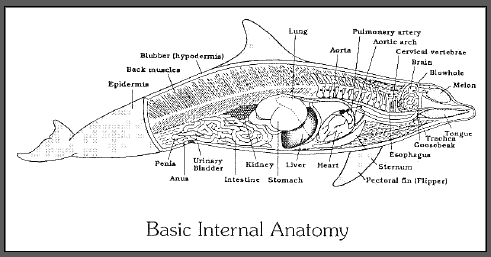DIGESTION

Image retrieved from:
The narwhal has a very similar system to that of their distant family, the dolphins, with the exception of some critical differences. Because the narwhal is a rather large organism, they have a very slow metabolism, move slowly, and do not use most of the energy obtained from digesting its food. Instead, it turns the food into blubber, which insulates the animal. Although similar to most mammals, They consume up to 5% of their body weight each day with their massive reserves of blubber comprising up to 40% of their body weight.
When the narwhal eats something, the food enters the mouth where it is presumably swallowed whole. From there, the food enters the pharynx, passes through the larynx to either side of the larynx. Then travels down the large esophagus into the stomach. They have a stomach with five compartments that work together to digest their food. Due to the absence of any salivary glands, all of the chemical digestion happens in the stomach. The primary compartment is an extension of the large esophagus. In this part of the stomach, the food is ground into an absorbable mush. The second compartment is lined with nipple-like structures that secrete necessary gastric juices and acids to chemically break down the food. In this compartment, the walls are far thicker and this is where digestion essentially happens. The third, fourth, and fifth compartments are all lined with pyloric glands to complete the digestion of the ingested food. The activity that occurs in the pyloric stomach is the last stop in digestion before the leftover food is taken into the intestines. Lastly, it is transported to the intestines where nutrient absorption occurs. The five-compartmented stomach allows the narwhal to break down their food in such a way that contributes to the construction of their blubber.